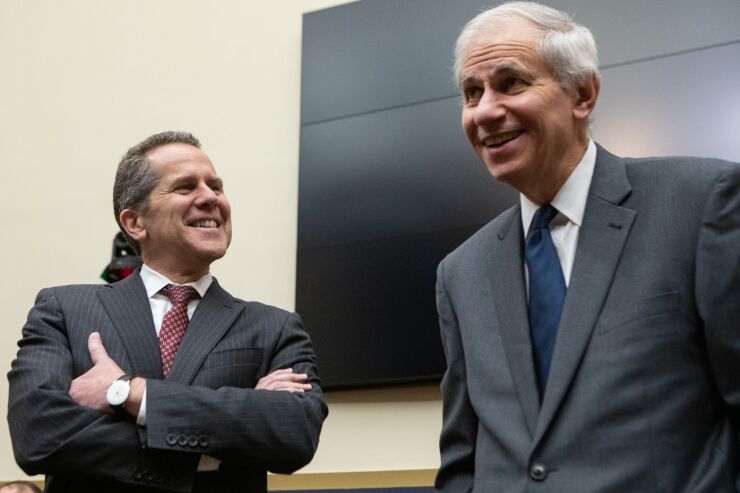
WASHINGTON — A
Speaking at the Brookings Institution Monday, Gruenberg said the proposals "are perhaps lessons we should have learned from the 2008 financial crisis," but added that "this time, if I may say, I don't think we're going to miss."
Gruenberg said the reforms will help ensure banking sector stability by bolstering depositor confidence and streamlining what have proved to be
Consumer advocacy groups lauded regulators for turning the screws on large regional banks, which they argue sowed the seeds for the reforms by supporting deregulation spurred by
"The banking Industry's baseless claims deregulated Silicon Valley Bank, Signature Bank, and First Republic Bank during the Trump administration and their collapse, contagion and crisis have now cost Americans more than $30 billion in bailouts plus a credit contraction and much more," he wrote in an email. "That objectively proves that banks with more than $100 billion in assets — just 33 banks out of nearly 4,700 in the country — are a systemic threat and need to be regulated with more capital and liquidity as well as workable resolution plans."
One of the major new requirements Gruenberg floated was a new long-term debt requirement that would make banks above $100 billion in assets hold more subordinated debt to increase their pad against bank runs — known as Total Loss Absorbing Capacity.
Banking groups said the floated reforms undermine the congressional intent of the 2018 law, which raised the threshold for enhanced reporting requirements from banks with over $50 billion to those with over $250 billion in assets.
"Indiscriminately requiring midsize and regional banks to meet the same 'capital refill' long-term debt standard as GSIBs also undermines Congress's determination in S. 2155 that prudential requirements should be tailored to the risk an institution presents," wrote Tabitha Edgens, senior vice president and senior associate general counsel of the Bank Policy Institute.
Analyst Jaret Seiberg of TD Cowen said this will surely increase regional banks' funding costs, but that Gruenberg's forthcoming proposal will likely need to be softened before it gains enough widespread regulatory approval to be issued.
"Whatever is proposed will likely need to be moderated before it can be finalized," he wrote in an email.
Gruenberg also indicated the agency wants the
This could include requiring banks to include in living wills how they might establish virtual platforms for interested acquirers to perform due diligence and bid on the institution. He also said the FDIC would consider requiring banks to furnish contingency items like plans to continue branch operations during bidding, personnel and retention plans and information on third-party relationships, payments and activities.
"These were all things we had to deal with, frankly in March and April," Gruenberg said.
Policy analyst Ian Katz, managing director at Capital Alpha Partners, thinks the enhanced resolution plans are a way for regulators to avoid a repeat of the confidence-shaking public struggle to find an acquirer for Silicon Valley Bank in March. It could also ultimately reduce regulators' reliance on "too big to fail" banks that are better equipped to rescue failed firms, but whose massive market share increasingly makes Biden-administration regulators uncomfortable.
"Gruenberg and the other bank regulators want to avoid the panicked over-the-weekend sale and make it less likely that one large bank has to take over a troubled bank," said Katz. "I think his speech reflects the unease regulators feel over the fact that these things tend to get done over a frantic weekend, with the result being that one very large bank gets larger."
Seiberg says that in addition to being costly for banks, Gruenberg's idea for enhancing banks' contingency planning could actually raise capital requirements.
"Gruenberg discussed requiring regional banks to have a plan about how individual businesses could be sold off in the event of a failure … [meaning] the agency could sell a bank in pieces rather than having to rely on a single buyer," wrote Seiberg in an email. "Our concern is that the way to make this happen would be to require those business lines to be separately capitalized."
A third major piece of Gruenberg's speech was about the outsize risk firms with high levels of uninsured deposits — like now-failed SVB and Signature — can pose to financial stability. He said the FDIC would look to heighten oversight of firms with a high threshold of uninsured deposit levels and even peg deposit insurance premiums to concentrations of uninsured deposits at regional banks.
Analysts like Katz said there is widespread agreement in Washington about the role uninsured deposits played in the March failures.
"I think there's widespread agreement that it's not a good thing for banks to have really high levels of uninsured deposits," he wrote over email. "If bank examiners are going to lean on banks to reduce their levels of uninsured deposits, I don't think there will be much pushback against that."
Seiberg agreed the deposit insurance reforms could end up getting bipartisan support.
"We question if either political party is going to fight the idea given how volatile uninsured deposit flows were this spring. As always, the details will matter. We are particularly focused on what this could mean for the biggest banks, which appear to have become the new home for uninsured deposits," he wrote.
American Bankers Association President Rob Nichols similarly expressed concern, arguing that Gruenberg's call for altering the supervisory treatment of uninsured deposits and labeling them as unstable for purposes of deposit insurance pricing may not adequately reflect the risks that some uninsured deposits pose versus others.
"As the FDIC considers possible changes, it must recognize that uninsured deposits are not uniform and not an accurate proxy for liquidity risk or the effectiveness of liquidity risk management," wrote Nichols in a release following the speech.






